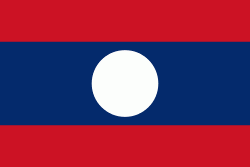Pakxan
Pakxan (Paksan or Muang Pakxan) (Lao ປາກຊັນ) (Paksane) is a district and a town in Bolikhamsai Province, in western Laos. It is the capital of Pakxan District. The Nam Xan River joins the Mekong River at Pakxan on the border with Thailand, opposite Bueng Kan. Pakxan is connected to the south of Laos by Route 13.
Pakxan was founded in the late-19th century. The Pakxan region had experienced insecurity since the invasion by Annam in 1834, followed by invasions by the Siamese, and Siamese sovereignty over Laos in 1836, and especially after 1865 with the invasions of Haws or "red flags", gangs from southern China. These invasions began to reduce the populations of Xieng Khouang and Bolikhamsai, but it was the Siamese who completed the depopulation by deporting most of the Phou Eun inhabiting the region.
In 1876, Rama V, King of Siam, ordered the creation of Bolikhamsai with the last survivors of the Haw invasion of 1874. Bolikhamsai was placed under the authority of Kha Luang Nong Khai. From 1885, the French who took over neighboring Vietnam, challenged Siamese sovereignty over Laos, and after Auguste Pavie's mission dating the Mekong to Luang Prabang, the Siamese were forced to leave the left bank of Mekong and evacuate the position they had created at the mouth of the Nam Xan River. At that time, Patchoum Muong (or Paxum) was the largest town near the confluence of the Nam Xan, but it is on the Nam Xan, a half-day by boat up the Mekong.
In the course of the 1890s, missionaries of the Missions étrangères de Paris, attached to the mission of Christianity to a Bangkok-based Keng-Sadok, on the Mekong River, a few miles from the mouth of the Nam Xan. Then the missionaries occupied Pakxan, abandoned by the Siamese, and there built a church. [4] In 1911, Bolikhamsai had about 61 villages with a population of about 4,000 inhabitants. In 1937, when Vientiane Province was cut in half, Pakxan alone had a population of 1,000 people and became the capital of the new province.
Pakxan was founded in the late-19th century. The Pakxan region had experienced insecurity since the invasion by Annam in 1834, followed by invasions by the Siamese, and Siamese sovereignty over Laos in 1836, and especially after 1865 with the invasions of Haws or "red flags", gangs from southern China. These invasions began to reduce the populations of Xieng Khouang and Bolikhamsai, but it was the Siamese who completed the depopulation by deporting most of the Phou Eun inhabiting the region.
In 1876, Rama V, King of Siam, ordered the creation of Bolikhamsai with the last survivors of the Haw invasion of 1874. Bolikhamsai was placed under the authority of Kha Luang Nong Khai. From 1885, the French who took over neighboring Vietnam, challenged Siamese sovereignty over Laos, and after Auguste Pavie's mission dating the Mekong to Luang Prabang, the Siamese were forced to leave the left bank of Mekong and evacuate the position they had created at the mouth of the Nam Xan River. At that time, Patchoum Muong (or Paxum) was the largest town near the confluence of the Nam Xan, but it is on the Nam Xan, a half-day by boat up the Mekong.
In the course of the 1890s, missionaries of the Missions étrangères de Paris, attached to the mission of Christianity to a Bangkok-based Keng-Sadok, on the Mekong River, a few miles from the mouth of the Nam Xan. Then the missionaries occupied Pakxan, abandoned by the Siamese, and there built a church. [4] In 1911, Bolikhamsai had about 61 villages with a population of about 4,000 inhabitants. In 1937, when Vientiane Province was cut in half, Pakxan alone had a population of 1,000 people and became the capital of the new province.
Map - Pakxan
Map
Country - Laos
 |
 |
| Flag of Laos | |
Present-day Laos traces its historic and cultural identity to Lan Xang, which existed from the 13th century to the 18th century as one of the largest kingdoms in Southeast Asia. Because of its central geographical location in Southeast Asia, the kingdom became a hub for overland trade and became wealthy economically and culturally. After a period of internal conflict, Lan Xang broke into three separate kingdoms: Luang Phrabang, Vientiane and Champasak. In 1893, the three territories came under a French protectorate and were united to form what is now known as Laos. It briefly gained independence in 1945 after Japanese occupation but was re-colonised by France until it won autonomy in 1949. Laos became independent in 1953, with a constitutional monarchy under Sisavang Vong. A post-independence civil war began, which saw the communist resistance, supported by the Soviet Union, fight against the monarchy that later came under influence of military regimes supported by the United States. After the Vietnam War ended in 1975, the communist Pathet Lao came to power, ending the civil war. Laos was then dependent on military and economic aid from the Soviet Union until its dissolution in 1991.
Currency / Language
| ISO | Currency | Symbol | Significant figures |
|---|---|---|---|
| LAK | Lao kip | â‚ | 2 |
| ISO | Language |
|---|---|
| EN | English language |
| FR | French language |
| LO | Lao language |















